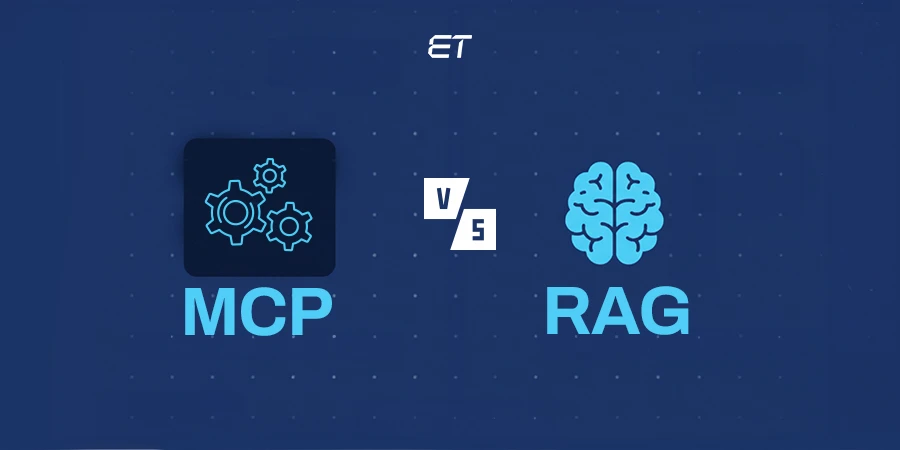
gRPC vs REST: A Detailed Guide for Modern API Development
- An API serves as a bridge that allows two software components to interact using defined protocols and specifications.
- APIs can be designed using various architectural styles, each offering unique advantages, limitations, and best-fit scenarios.
- This guide covers a comprehensive comparison of two popular architectural styles for building APIs: gRPC vs REST.
- gRPC is a high-performance RPC framework using HTTP/2 and Protocol Buffers.
- The REST API is a stateless web API style that uses HTTP and resource-based communication with JSON or XML payloads.
- REST remains the most popular API style, but gRPC is gaining popularity due to features such as streaming and code generation. This article explores when to choose one over the other.
According to the Deloitte Report, the API management market is expected to continue growing at a 34.42% compound annual growth rate (CAGR), underscoring the increasing demand for advanced API solutions. It signals the widespread adoption by businesses and developers, who recognize APIs as essential tools for innovation and digital transformation.
There are two different approaches for creating APIs: gRPC and REST. When it comes to online API development, REST has long been the industry standard. However, gRPC has become a potent substitute, offering a more effective binary protocol than REST’s traditional text-based formats, such as JSON or XML.
Is gRPC superior to REST? It’s a frequent question among both developers and tech enthusiasts. To understand REST and gRPC effectively, it’s important to grasp their strengths and weaknesses.
Comparing gRPC vs REST performance, gRPC excels because it provides bidirectional streaming and utilizes Protocol Buffers to serialize data at an incredibly fast rate. REST APIs are easier to use, more adaptable, and more appropriate for use with web-based applications or when working with other programming languages.
However, before diving into the debate between REST and gRPC, we’ll first define what an API is and its crucial role in microservices architecture—laying the groundwork for a clearer understanding of this blog.
Let’s get started!
What is an API, and why is it the backbone of microservices architecture?
A microservices-based architecture breaks down a monolithic application into independent services, or microservices, each running autonomously and communicating with one another via APIs.
This approach enables a pluggable, component-based system where services can be built in different languages or platforms. APIs play a key role by allowing seamless interaction between services, resulting in more efficient, scalable, and robust application architectures tailored to specific needs.
Serverless vs Microservices: Which Architecture Is Best for Your Next Project?
In microservices systems, APIs essentially serve as a glue between system components written in various programming languages. An interface is necessary for these components to communicate.
The API is this interface.
Mastering React Micro Frontend: A Deep Beginner’s Guide
If there were no APIs, there would be no consensus on how various software services and apps should communicate with each other. In such a situation, the programmers of two different applications would have to speak with one another to determine how to implement the data exchange each time.
An API is like using a vending machine. You, the client, select an item by pressing a button that corresponds to what you want—say, a soda or a snack. The vending machine (the server) receives your request, processes it internally, and delivers the item without requiring you to understand how the machine works inside.
The vending machine has a fixed set of products and a clear, predictable response to your input, just like an API. This standard, simplified interface allows any user to interact with the machine in the same way, regardless of the product they choose.
An API architectural style defines rules for building APIs and client-server interaction. Out of gRPC vs REST, REST emphasizes statelessness and resource access, while gRPC focuses on performance and streaming. These styles dictate request structure, protocols, payload formats, and expected responses.
Let’s delve deeper into each of these architectural styles to gain a clearer, more nuanced understanding of how they function and when to utilize them effectively.
Demystifying gRPC: What It Is, How It Works, and Why It Matters?

“Google Remote Procedure Call,” or “gRPC,” is an open-source, high-performance framework that facilitates effective communication between distributed systems. This API architecture implements the Remote Procedure Call (RPC) protocol, allowing services to call functions on other machines as if they were local software methods.
gRPC is a suitable option for microservices architectures, streaming applications, Internet of Things (IoT) device connections, and APIs in distributed contexts, especially those requiring real-time communication, as it also supports HTTP/2, which enables bidirectional streaming.
Best Microservices Framework: A Handy Listicle
Google created it initially to enhance communication. The Remote Procedure Call (RPC) model is represented by the letter “RPC” in gRPC. In gRPC, the letter “g” stands for Google. Google’s implementation of RPC is hence known as gRPC. gRPC is especially well-suited for multilingual and real-time streaming systems, despite its browser compatibility issues.
These RPC frameworks offer advantages such as network connection abstraction and simpler development, and they are lightweight and quite easy to use. However, more robust performance frameworks are often required in situations such as microservices architectures and systems with large data loads, and gRPC was designed to address this need.
How does the gRPC API work?
This API architecture enables multiple functions written in various programming languages to collaborate effectively. gRPC API enables clients to call methods on remote servers as if they were local functions. gRPC serializes structured data using the Protocol Buffers (protobuf) messaging format, which is a highly efficient and compact messaging format. Let’s break down the working of gRPC!
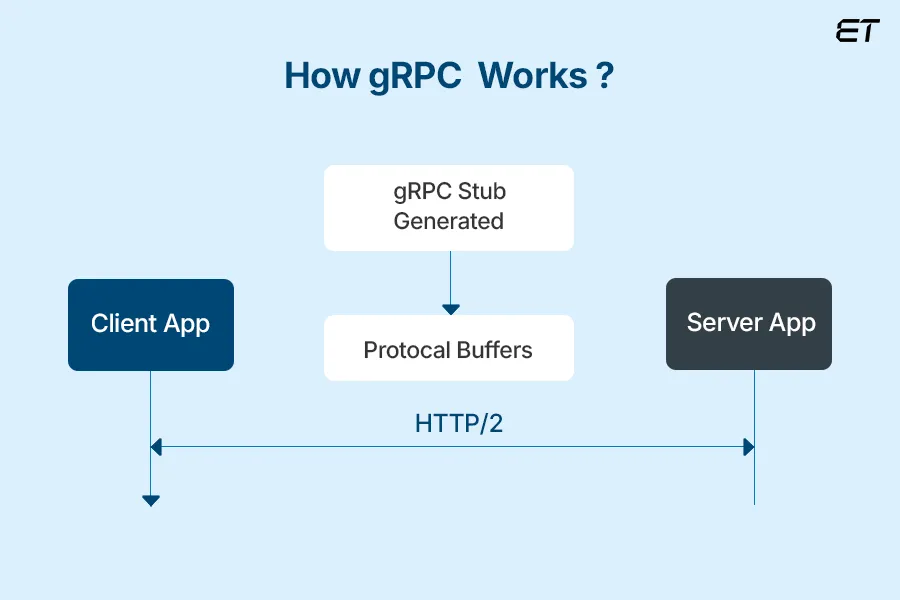
- Define Service in .proto file: The developer writes a .proto file using Protocol Buffers to define the service and its methods.
- Generate Code: gRPC tools generate client and server code in the desired language (e.g., Python, Go, Java).
- Implement Server Logic: The server implements the logic for the defined methods.
- Create Client: The client uses the generated code to call the server methods as if they were local.
- Communication via HTTP/2: gRPC uses HTTP/2 for efficient, low-latency, multiplexed communication between client and server.
- Serialization with Protobuf: Messages are serialized using Protocol Buffers, making them compact and efficient for transmission.
Why use gRPC?
As previously said, gRPC defines the services and messages for communication using the Protocol Buffers (Protobuf) language-agnostic interface specification language. Thus, the benefits of gRPC inherently encompass those of HTTP/2. Let’s talk about a few typical ones!

-
High Performance
Through server push, multiplexing, and header compression, HTTP/2 improves performance. Additionally, small and compact message payloads are generated through Protobuf’s rapid serialization of messages on both the server and client sides. This enables faster loading by proactively transmitting content, preventing head-of-line stalling, and using sophisticated compression techniques to reduce message size.
Find Performance Optimization Techniques in Front-End Development
-
Built-in Commodity Feature
gRPC comes equipped with native support for essential capabilities like metadata handling, secure encryption, user authentication, request timeouts and cancellations, middleware (interceptors), load balancing, service discovery, and various other advanced functionalities, making it highly robust for modern distributed systems.
-
Cross-Platform and Multilingual
gRPC supports numerous programming languages, including Java, Go, C++, Python, Ruby, C#, Node.js, and more. This makes it ideal for polyglot microservices architectures, as it enables seamless communication between services built in various languages.
Programming Languages for Web Development in 2025
-
Bidirectional Streaming
gRPC supports four service methods: unary, client-streaming, server-streaming, and bidirectional-streaming, enabling efficient real-time data exchange. It leverages HTTP/2 for seamless streaming, sending or receiving large data in chunks without delay. This persistent connection ensures reliable communication, making it ideal for real-time applications such as gaming, chat, or live data feeds.
-
Automatic Code Generation
The native code generation for client/server applications is the main characteristic of the gRPC methodology. By creating client and server stubs from .proto files, gRPC tools lower boilerplate and increase developer efficiency. It can create client-side network stubs and server-side skeletons, which significantly reduces development time for applications with multiple services.
-
Robust Authentication and Security
API security is ensured with gRPC by using HTTP/2 instead of TLS end-to-end encryption. Secure data transfer is further guaranteed by integrated support for SSL/TLS encryption. In addition to being compatible with modern identity management systems, it also supports token-based authentication.
Front End Security Best Practices to Implement
Demystifying REST: What It Is, How It Works, and Why It Matters?
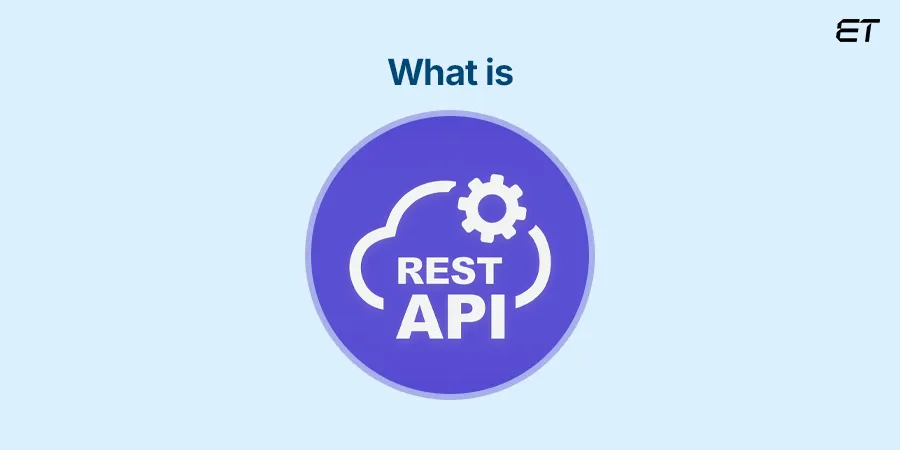
A REST API is a web service since it sends messages using the HTTP protocol. This is the most popular method for building an API.
REST APIs utilize the HTTP protocol to facilitate communication between platforms and systems built in different programming languages. For instance, an API server developed in Java can communicate with a Python client application.
Python vs JavaScript: Choosing the Best Language
Because JSON is straightforward, readable, and cross-platform compatible, it is frequently used in REST APIs. Microservices and online applications can communicate easily and effectively thanks to JSON, which enables seamless data interchange.
REST APIs carry out standard database operations using HTTP requests, also known as HTTP methods, such as GET, POST, PUT, and DELETE. These methods perform the CRUD actions—create, read, update, and delete resource records. Endpoints, which are specific URLs, identify the resources on the server.
REST is appealing for many projects, including web and mobile development, because it separates client and server concerns.
How does the REST API work?
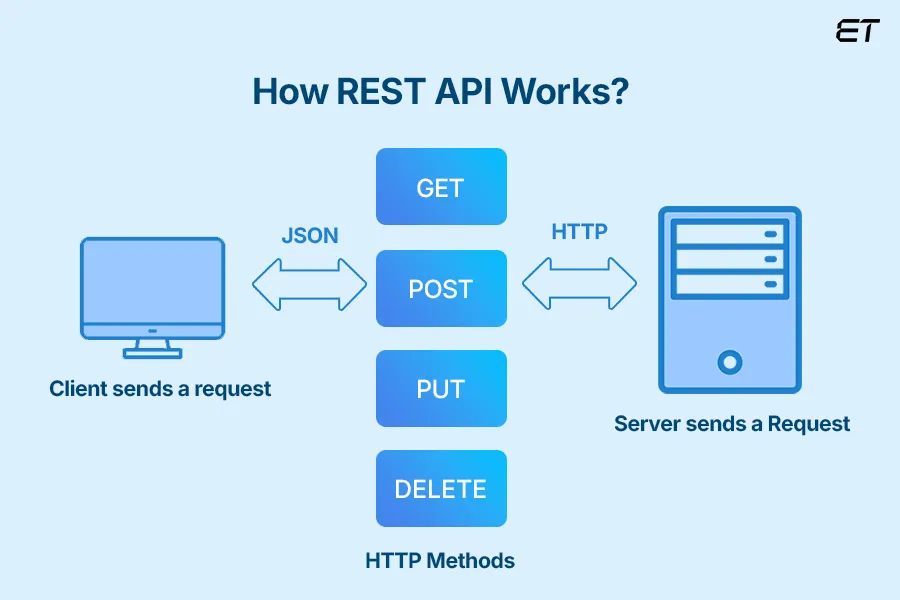
The server returns the resource’s current state in a standardized representation when a client uses a REST API to access it. To put it another way, REST APIs process requests for resources and provide all pertinent data about them in a manner that is easy for clients to understand (the format is decided by the API accepting requests). Through a REST API, clients can also upload new objects to the server and change existing ones.
REST API requests and responses may vary slightly depending on the specific architecture and design choices made by the developers implementing the API, leading to differences in structure and behavior.
Here are the general steps for any REST API call:
- Client Prepares Request: Follows API documentation to structure a valid request.
- Send Request: The client sends the HTTP request (GET, POST, PUT, DELETE) to the API endpoint.
- Authentication: The server verifies client credentials via tokens, API keys, or OAuth.
- Process Request: The server receives and interprets the request.
- Perform Action: The server accesses or modifies the resource as per the request.
- Send Response: The server returns an HTTP response with status codes, headers, and a response body.
- Client Handles Response: The client processes the returned data or error message.
Why use REST?
Let’s explore the key benefits of utilizing this API architecture model over gRPC.
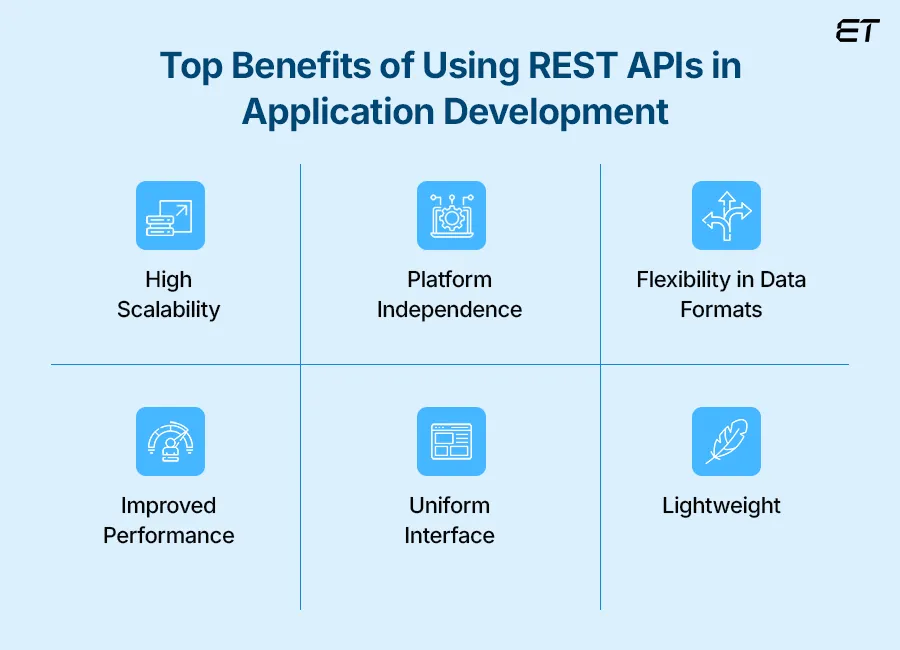
-
High Scalability
REST’s modular architecture and stateless characteristics facilitate horizontal scaling. You can add additional servers without needing to share state, allowing the system to effectively manage a large number of mobile devices and internet users.
-
Platform Independence
REST APIs use standard web protocols, enabling cross-language communication between clients and servers. Their separation allows for independent development, and adaptability supports testing across various environments, making them ideal for versatile and efficient software development and integration.
-
Flexibility in Data Formats
REST-style APIs support server migrations by ensuring that data in requests is transmitted correctly, thereby maintaining consistency during transitions. They also allow real-time database modifications, offering flexibility. This adaptability enables easier accommodation of the evolving needs and requirements of different applications across various platforms and development environments.
-
Improved Performance
REST APIs follow a layered architecture, allowing services like load balancers and firewalls to integrate without affecting client-server communication. Caching and CDNs boost performance and reduce server strain. Independent API handling across domains improves resilience and scalability.
-
Uniform Interface
REST enforces a consistent structure for accessing resources, promoting standardization and making APIs more predictable, easier to document, and more accessible for consumption.
-
Lightweight
As REST APIs utilize the HTTP standard, which supports various formats such as HTML, XML, and JSON, they are quick and lightweight. Due to their simplicity, they are ideal for mobile and web applications that require efficient, fast, and scalable client-server communication.
gRPC vs REST API: Exploring Their Core Similarities

gRPC and REST, while different, share key similarities as API architectural styles. Both enable scalable system design, support cross-language communication, follow a client-server model, and use standardized protocols to facilitate reliable data exchange between distributed components. Before getting into the fight between REST vs gRPC, let’s cover what is common between them.
| Client-Server Architecture | Both REST and gRPC are systems with client/server architectures. In both cases, clients submit requests to servers, and servers respond by processing the requests. |
| HTTP-Based Communication | Both transmit information over the HTTP request-response mechanism, which is the web’s primary and most effective communication protocol. However, REST relies on HTTP/1.1, whereas gRPC utilizes HTTP/2. |
| Platform and Language Agnostic | Both REST and gRPC can be implemented across multiple platforms and programming languages, ensuring broad system compatibility and interoperability. Applications created in different programming languages can use these APIs because both architectural patterns are language-independent. |
| Support for Secure Communication | Both REST and gRPC support secure data transmission via TLS (Transport Layer Security). This ensures that data exchanged between clients and servers remains confidential and protected from tampering or interception. |
| Stateless Communication | Since both REST and gRPC are designed to be stateless, every request contains all the data needed to complete it. Consequently, the server is not required to maintain any session state. |
| Data Exchange Mechanism | Both enable a client and server to communicate and exchange data using a common set of rules, regardless of their internal implementations. These shared rules ensure seamless interaction between different systems, promoting compatibility and interoperability across various platforms. |
Real-Time API Guide: What is it, Benefits, and Best Practices
gRPC vs REST: A Head-to-Head Look at API Communication Protocols

REST and gRPC are two prominent methods for service-to-service communication. While REST has long been the de facto standard for web APIs, gRPC, developed by Google, has gained popularity due to its superior performance and efficiency. When it comes to gRPC vs REST performance, gRPC offers faster communication and lower latency, making it ideal for high-throughput systems. Let’s move on to a detailed comparison of REST vs. gRPC, helping you understand their differences and decide which one best fits your use case.
-
Protocol Wars: REST’s HTTP/1.1 vs gRPC’s HTTP/2
Out of gRPC vs REST, REST communicates, sends requests, and receives responses using HTTP/1.1. In contrast, gRPC makes use of HTTP/2.
Introduced in 1997, HTTP/1.1 is a text-based protocol that enables clients and web servers to exchange resources and requests, such as HTML or PDF files. Introduced in 2015, HTTP/2 is broadly supported by modern browsers and improves upon HTTP/1.1 by using a binary format, enabling faster and more efficient communication between clients and servers. It has multiplexing capabilities, which reduce network latency and improve performance by allowing multiple requests to be sent over a single connection simultaneously.
Based on the HTTP 1.1 protocol, REST offers a request-response communication architecture; as a result, it lacks multiplexing capabilities. Resources are loaded sequentially, with each resource waiting for the previous one to complete loading.
The challenge is not the same for gRPC. Instead, it is based on HTTP 2 and uses a client-response communication mechanism. gRPC’s ability to handle multiple requests from different clients simultaneously and process them through continuous data streaming enables efficient bidirectional and streaming communication. Additionally, gRPC is capable of handling “unary” interactions, such as those based on HTTP 1.1.
Mastering API Development: A Comprehensive Guide
REST APIs can be developed on HTTP/2, but they are unable to fully utilize the benefits of HTTP/2, including bidirectional support and streaming communication, due to the unchanged request-response communication architecture.
To ensure that no resources are blocked, gRPC utilizes HTTP/2 to provide multiple data streams, each divided into binary-coded messages and numbered. This way, the client can determine which binary message corresponds to which stream.
-
gRPC vs REST: Unpacking Communication Patterns
Responses are sent and received using various forms in gRPC and REST. JSON, a text-based format used by REST, is adaptable, effective, platform-neutral, and language-independent. In contrast, gRPC utilizes Protobuf, a binary format that, due to serialization, enables faster message delivery. The technique of encapsulating the remote function and parameters in a binary message is called serialization.
Protobuf and JSON are both platform-independent, meaning they can be used and developed on any platform. A brief comparison of them is provided here.
gRPC Protobuf vs REST JSON
| Features | Protobuf | Json |
| Use Cases | Internal APIs, gRPC | Public APIs, REST |
| Format | Binary | Text (Human-readable) |
| Speed | Faster serialization/deserialization | Slower compared to Protobuf |
| Payload Size | Smaller | Larger |
| Schema | Strongly typed (.proto files) | Schema-less |
| Readability | Not human-readable | Easy to read |
| Efficiency | High (better for large-scale APIs) | Moderate |
Although data transmission with JSON is slower, its flexibility and support for dynamic schema evolution make it a popular choice in tutorials and among API development companies. In contrast, Protobuf offers faster binary serialization but lacks JSON’s adaptability for dynamic schema changes.
gRPC vs REST: Exploring Code Generation Workflows
Although REST APIs can be developed with a variety of programming languages, they do not offer native support for code creation. REST APIs lack built-in code generation, so developers typically use third-party tools, such as Swagger or Postman, to generate API call code. Unlike gRPC, REST clients rely on external tools for message translation, and servers must also convert incoming requests into their native programming language for handling.
gRPC supports a number of programming languages and provides native code creation via its protoc compiler. In microservices architectures, where services are developed utilizing a variety of platforms and languages, this is particularly beneficial. Creating SDKs is also made easier by gRPC’s integrated code generator.
Therefore, out of gRPC vs REST, if you decide to go with gRPC instead of REST, you will have the advantage of auto-generated stubs, which will remove the requirement for third-party tools to translate messages. Message conversion into the server’s programming language is handled automatically by gRPC on the server side, simplifying development and ensuring consistent and effective communication between services.
Top 10 API Integration Tools for 2025
gRPC vs REST: Architectural Design Patterns You Should Know
When designing modern APIs, understanding the architectural design patterns of gRPC and REST is essential for selecting the most suitable approach based on project requirements.
The design of REST APIs is resource-oriented, meaning that clients access resources via specific API endpoints using a defined set of HTTP methods. It works with resources identified by URLs using common HTTP methods, such as GET, POST, PUT, and DELETE.
Since REST APIs are stateless, every request made by the client to the server must include all the necessary data for the server to comprehend and process it. REST is therefore suitable for web-based applications, particularly when user-friendliness, human readability (via JSON), and broad browser compatibility are key considerations.
gRPC APIs, in contrast, employ a service-oriented design where you define callable functions on the server, enabling the client to invoke them just as it would call local or internal functions within its own application. It uses binary Protobuf messages to communicate via HTTP/2 and specifies services and methods in .proto files. It’s closely related contract-first methodology enables high-performance, effective communication across services built in various languages.
Ultimately, gRPC excels in internal, performance-critical, microservice-based systems, whereas REST is more suitable for open, web-friendly contexts. The use case, infrastructure, and performance requirements all influence the selection of the pattern.
Find API Design Best Practices in 2025
gRPC vs REST : Coupling and Its Impact on Scalability
Coupling refers to the level of dependency between system components.
Due to the close coupling between the client and server in gRPC, the middleware proto file must be accessible to both parties. Any modification to one necessitates a modification to the other.
Although this improves consistency and performance, it may reduce agility in dynamic settings. However, the close integration of gRPC can be advantageous in microservices, where robust contracts guarantee dependability and consistent communication. When evaluating gRPC vs REST performance, this tight coupling in gRPC contributes to faster data exchange and lower latency compared to REST, making it highly effective in high-performance environments.
REST allows for a loose coupling as clients employ defined HTTP methods and resource URLs to communicate with server resources. Due to this independence, adjustments to one element have no impact on the other.
Thus, regarding coupling out of REST vs gRPC, gRPC promotes high-performance communication with highly regulated service interactions, whereas REST enables wider compatibility and ease of scaling. System requirements and scalability objectives determine which option is best.
-
gRPC vs REST: Understanding Streaming and Data Flow
The communication patterns used by REST and gRPC are different. REST is built on a request-response model, where the client sends a single request and receives a single response from the server. Within REST, HTTP/1.1 supports only unary communication and does not facilitate streaming capabilities. In this type of streaming, the client sends a single request, and the server responds with a single response.
In contrast, gRPC uses HTTP/2 for communication, which, as previously mentioned, supports multiple data streams and traditional request-response interactions over a single TCP connection. Leveraging this, gRPC provides several streaming options for efficient data exchange.
Server-side: A client sends a request message to a server. The client receives a stream of replies from the server. In order to complete the operation, the server sends a status message once all the data has been transmitted.
Client-side: A single client can simultaneously send multiple messages to the server. There is only one answer from the server.
Bidirectional: It is initiated and terminated by the client. In this type of streaming, data is sent back and forth between a client and a server in any sequence. In this type of streaming, both the client and the server send messages simultaneously.
gRPC vs REST: Browser Support Face-Off
On the one hand, every browser fully supports REST. However, in terms of browser compatibility, gRPC remains quite restrictive.
Since REST doesn’t require any special software and does support browsers, it is the obvious winner in this regard.
Due to limited browser support, particularly in older versions, gRPC needs gRPC-web and a proxy layer to translate between HTTP/1.1 and HTTP/2. Because of this, gRPC is currently most appropriate for private or internal backend services.
REST vs gRPC: When to Use Each in Real-World Projects?
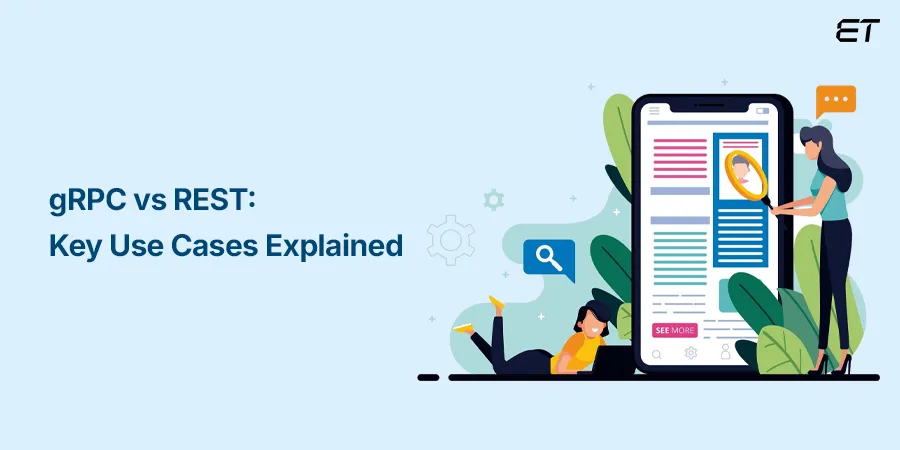
Understanding when to use gRPC vs REST depends on several factors, including performance needs, scalability, ease of development, and compatibility with existing systems. According to leading API development companies, choose gRPC when you need speed, efficiency, and robust service-to-service communication, while REST is a go-to option for simplicity, broad accessibility, and integration with the web ecosystem. Let’s examine the best use cases for both API protocols.
gRPC in Action: Common Use Cases Across Industries
| Best Use Cases of gRPC API | Explanation |
| Microservices Communication | It is ideal for internal communication between microservices in distributed systems due to efficient binary serialization and strong typing. |
| Streaming Data | It is perfect for scenarios involving continuous data exchange, such as chat apps, live feeds, or video/audio streaming, thanks to support for client, server, and bidirectional streaming. |
| Cross-Language Support | gRPC is well-suited for polyglot environments, as it allows seamless communication between services written in different programming languages. |
| Lightweight Payloads | Its binary Protobuf format significantly reduces payload size, ideal for bandwidth-constrained environments or IoT systems. |
| Internal APIs | Best used for private/internal APIs where browser support isn’t required, allowing full use of HTTP/2 features. |
| Strongly Typed Contracts | gRPC is best suited when your project benefits from clearly defined service interfaces and automatic code generation in multiple languages, utilizing .proto files. |
| High Performance Needs | Use gRPC when your application requires low latency and high throughput, such as in real-time systems or mobile backends. |
REST Use Cases: Where REST APIs Still Reign Supreme
| Best Use Cases of REST API | Explanation |
| Web and Mobile Applications | REST works seamlessly with front-end technologies like JavaScript, making it perfect for web and mobile apps that rely on standard HTTP calls. |
| Public-Facing APIs | REST is ideal for building APIs meant for public consumption, thanks to its simplicity, wide adoption, and compatibility with HTTP/1.1. |
| Simple CRUD Operations | When your API primarily performs Create, Read, Update, and Delete operations on resources, REST’s resource-oriented architecture is a natural fit. |
| Human-Readable Format | JSON is easy to read, debug, and test, making REST a great choice during early development stages or in teams with varying levels of experience. |
| Loose Coupling | REST’s stateless nature promotes loosely coupled services that are easier to scale and update independently. |
| Wider Tooling and Community Support | REST enjoys vast community support and integrates well with tools like Postman, Swagger (OpenAPI), and various HTTP clients. |
| Browser-Based Access | Since REST utilizes standard web protocols and formats, such as JSON, it’s easily accessible from browsers without requiring additional configuration. |
Boosting Efficiency with Low-Code API Development Solutions
Let’s Conclude: REST vs gRPC, Which One Wins in 2025 and Beyond?
Selecting the right communication protocol is crucial when developing APIs for real-world applications. In 2025, APIs are evolving with two widely used architectures—gRPC and REST—each offering distinct benefits and drawbacks depending on the use case and system requirements. It is essential for modern software development to comprehend the distinctions between them.
REST APIs are popular because of their text-based communication and ease of use, particularly in microservices. Using HTTP/2, gRPC is a high-performance binary protocol that provides speedier service-to-service communication.
For creating distributed systems and enabling communication between client and server applications, both gRPC and REST are frequently utilized. Therefore, your choice should be guided by your specific requirements, as each architectural style is designed to perform best in specific scenarios.
The architectural style you choose will depend on the type of application you want to create. The characteristics of REST make it ideal for browser-supported, public-facing APIs, while gRPC’s tiny payloads and bi-directional streaming make it suitable for IoT and mobile development.
We hope this blog clarified the key similarities and differences between gRPC and REST. If you have any questions or need further assistance, don’t hesitate to reach out to our API development team—we’re always here to help!
Frequently Asked Questions
-
What fundamentally distinguishes gRPC from REST?
The key difference is that gRPC utilizes HTTP/2 and binary serialization (Protocol Buffers) for faster and more efficient communication, whereas REST relies on HTTP/1.1 and text-based JSON, prioritizing simplicity, readability, and widespread browser compatibility.
-
In what areas does REST hold an advantage over gRPC?
REST offers advantages in simplicity, broader browser support, and easier debugging. It’s widely adopted, well-documented, and compatible with standard web tools, making it ideal for public APIs and quick integration across diverse systems.
-
Does gRPC truly outperform REST in terms of speed and efficiency?
Yes, gRPC generally outperforms REST in speed and efficiency due to its use of HTTP/2, binary serialization via Protocol Buffers, and support for multiplexing, making it ideal for high-performance, low-latency applications.
-
Is it possible to integrate both gRPC and REST within a single project?
Yes, it’s absolutely possible to integrate both gRPC and REST in a single project. We have used REST for public-facing APIs and gRPC for internal microservice communication, leveraging the strengths of both architectures based on specific requirements. Let’s connect to learn more!
-
What factors are driving the growing popularity of gRPC over REST?




